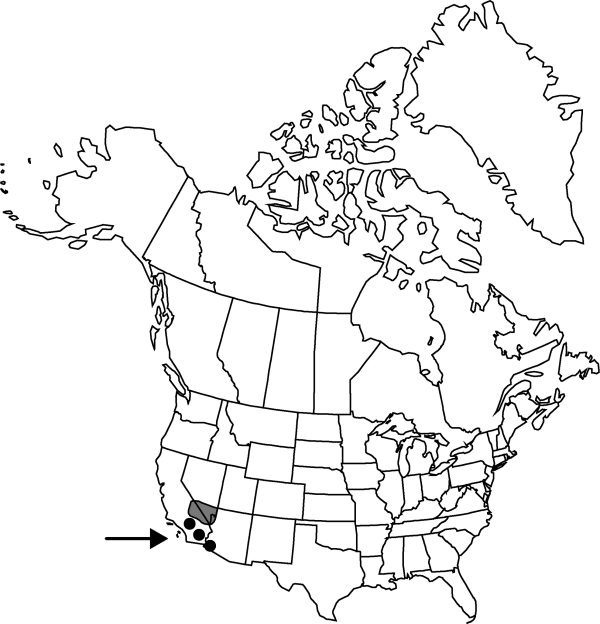familyCactaceae
subfamilyCactaceae subfam. Cactoideae
genusEchinocactus
speciesEchinocactus polycephalus
Difference between revisions of "Echinocactus polycephalus var. polycephalus"
Treatment appears in FNA Volume 4. Treatment on page 190.
FNA>Volume Importer |
FNA>Volume Importer |
||
| Line 12: | Line 12: | ||
}}<!-- | }}<!-- | ||
| − | --><span class="statement" id="st- | + | --><span class="statement" id="st-undefined" data-properties=""><b>Stems </b>gray-green. <b>Spines</b> red to gray, infrequently straw colored, canescent. <b>Fruit</b> scales reddish to maroon, aging tan or black, 10–14 mm, usually shorter than dried tepals at fruit apex, spine tips canescent with strap-shaped, unicellular trichomes. <b>Seeds</b> rounded or faceted with flat planes transversing testa, 2.8–4.7 mm, papillate-roughened (exposed surfaces of testa cells protruding, hemispheric to hexagonally faceted, appearing dull except for microscopically sparkling individual facets). <b>2n</b> = 22.</span><!-- |
-->{{Treatment/Body | -->{{Treatment/Body | ||
| + | |phenology=Flowering Jul–Aug. | ||
|habitat=Rocky flats and washes, bajadas, rock ledges, Mojave and Sonoran desert scrub, igneous and calcareous substrates | |habitat=Rocky flats and washes, bajadas, rock ledges, Mojave and Sonoran desert scrub, igneous and calcareous substrates | ||
|elevation=[10-]30-1700 m | |elevation=[10-]30-1700 m | ||
| Line 33: | Line 34: | ||
|basionyms= | |basionyms= | ||
|family=Cactaceae | |family=Cactaceae | ||
| + | |phenology=Flowering Jul–Aug. | ||
|habitat=Rocky flats and washes, bajadas, rock ledges, Mojave and Sonoran desert scrub, igneous and calcareous substrates | |habitat=Rocky flats and washes, bajadas, rock ledges, Mojave and Sonoran desert scrub, igneous and calcareous substrates | ||
|elevation=[10-]30-1700 m | |elevation=[10-]30-1700 m | ||
| Line 40: | Line 42: | ||
|publication year= | |publication year= | ||
|special status= | |special status= | ||
| − | |source xml=https://jpend@bitbucket.org/aafc-mbb/fna- | + | |source xml=https://jpend@bitbucket.org/aafc-mbb/fna-data-curation.git/src/9216fc802291cd3df363fd52122300479582ede7/coarse_grained_fna_xml/V4/V4_356.xml |
|subfamily=Cactaceae subfam. Cactoideae | |subfamily=Cactaceae subfam. Cactoideae | ||
|genus=Echinocactus | |genus=Echinocactus | ||
|species=Echinocactus polycephalus | |species=Echinocactus polycephalus | ||
|variety=Echinocactus polycephalus var. polycephalus | |variety=Echinocactus polycephalus var. polycephalus | ||
| − | |||
| − | |||
| − | |||
| − | |||
| − | |||
| − | |||
| − | |||
| − | |||
| − | |||
| − | |||
| − | |||
| − | |||
| − | |||
| − | |||
| − | |||
}}<!-- | }}<!-- | ||
-->[[Category:Treatment]][[Category:Echinocactus polycephalus]] | -->[[Category:Treatment]][[Category:Echinocactus polycephalus]] | ||
Revision as of 14:07, 27 July 2019
Stems gray-green. Spines red to gray, infrequently straw colored, canescent. Fruit scales reddish to maroon, aging tan or black, 10–14 mm, usually shorter than dried tepals at fruit apex, spine tips canescent with strap-shaped, unicellular trichomes. Seeds rounded or faceted with flat planes transversing testa, 2.8–4.7 mm, papillate-roughened (exposed surfaces of testa cells protruding, hemispheric to hexagonally faceted, appearing dull except for microscopically sparkling individual facets). 2n = 22.
Phenology: Flowering Jul–Aug.
Habitat: Rocky flats and washes, bajadas, rock ledges, Mojave and Sonoran desert scrub, igneous and calcareous substrates
Elevation: [10-]30-1700 m
Distribution

Ariz., Calif., Nev., Mexico (Sonora).
Discussion
Selected References
None.
Lower Taxa
None.